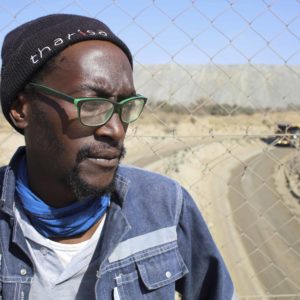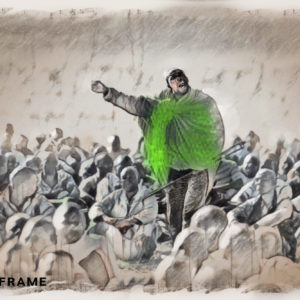Mountains and massacres
Many who gathered on the ‘koppie’ in Marikana in 2012 were from emaMpondweni with direct links to those who met on Ngquza Hill during the Mpondo revolt in 1960.
Author:
16 August 2021

In eastern emaMpondweni in the former Transkei Bantustan there were uprisings in the late 1950s and early 1960s. Known to many of its protagonists as the mountain movement, it has been recognised as the foremost instance of apartheid-era rural resistance in South African history. Thousands of people participated in a meeting on Ngquza Hill, popularly known as Ngquza Mountain, near the town of Flagstaff on 6 June 1960. Apartheid security forces attacked them, killing at least 11 people and injuring many more.
Although focused on state attempts to regulate agricultural and other practices, the Mpondo revolts were part of a broader wave of major protests, including the marches in Langa and Sharpeville in March 1960, both of which also ended in state massacres. But, unlike these urban protests that have taken on an iconic form in official national memory, academics and public commentators seldom invoke the Mpondo revolts as historical events through which to understand contemporary protests and state violence in South Africa. This was evident in the early academic writing about the massacre at Marikana in August 2012. Connections to Sharpeville were drawn almost immediately, but it was a long while before the empirical and political links between the actors and repertoires of struggle at Marikana and those associated with the Mpondo revolts were noted.
Related article:
Of the 44 people who were killed at Marikana during the strikes, 31 were migrant workers from the Eastern Cape. The Eastern Cape, and emaMpondweni specifically, has been a primary source of cheap labour for mining in South Africa since the opening of the first gold mines on the Witwatersrand in the late 1800s. Men from emaMpondweni historically dominated rock drilling, the most dangerous and labour-intensive part of mining minerals like gold and now platinum.
Rock-drill operators initially led and organised the Marikana strike. Later, workers from across the mining occupational categories joined them, as did residents of eNkanini shack settlement. The men gathered on what was termed “the koppie” in the media but referred to as eNtabeni, the mountain, by the strikers. While on the mountain, women from eNkanini settlement gave them vital support.
Grassroots activists immediately understood the significance of this. Soon after the men went to the mountain, Mnikelo Ndabankulu, a leader in Abahlali baseMjondolo in Durban with roots in Flagstaff, phoned his comrades from the mountain so that they could listen to the men singing a song that had been composed during the Mpondo revolts and sung on Ngquza Hill.
One thread in the many connections between the Mpondo revolts and the wildcat strike at Marikana more than 50 years later is the way in which popular resistance gathered on mountains. They became sites of resistance and spaces for participatory and egalitarian forms of politics to be conducted at a distance from the state and, at Marikana, the ruling party and its allied union, the National Union of Mineworkers (NUM).
It is significant that most of the rock-drill operators who were at the centre of the strike at Marikana were migrant workers from emaMpondweni aged between 45 and 55 years old. In many cases their parents and older relatives were involved in the mountain movement in emaMpondweni.
The politics of the mountains
The idea that mountains are sacred has ancient roots and endures in various ways. The practice of meeting on mountains is documented from the early years of the 1900s in the former Transkei. From there it was carried all over the country by migrants but, most significantly, to the mines on the East Rand.
In South Africa, the radical tradition of rural resistance that migrant workers carried into the mines associated the space of the mountain with a collective and egalitarian politics, a type of politics opposed to autocratic and elitist rule. This organic and horizontal mode of politics places emphasis on the popular meeting as the most important site of political thought and action. There is a well-documented and an overarching commitment to participatory modes of collective and consensus decision-making processes. Spokespeople rather than leaders are elected.
Related article:
Striking miners at Marikana refused union representation. This was reminiscent of the autonomous modes of political organisation deployed during the Mpondo revolts in which the institution of the chieftaincy and all of its officials were rejected in favour of more direct forms of engagement between political crowds and state authorities.
In both instances, people chose to occupy a mountain and, via means of democratic consensus, elected a mountain committee to facilitate consensus-based decision-making, maintain peace and order, and act as spokespeople. People were treated as equals in the space of the mountain, and insisted on their right to speak for themselves via their own spokespeople and not state-endorsed representatives. From emaMpondweni to Marikana, and Ngquza Hill to eNtabeni, the politics of the people on a mountain took the form of a conception and practice of democracy infused with a radical commitment to equality. This is also present in some forms of contemporary organising in shack settlements in Durban, where it is explicitly understood to have rural roots. Here, in a context in which women are the majority, women are full and equal participants in the meeting.
Political parties, non-governmental organisations and other elite forms of politics have systematically failed to recognise or understand this mode of politics. There is a relentless categorisation of impoverished or working-class Black people with direct ties to the rural areas as the “raw working classes”, the less-than-modern “unthinking masses”, as those in perpetual need of guidance by some kind of “enlightened” vanguard. Prejudice, rooted in ignorance, is assumed to be knowledge. This has been strikingly present in parts of the academic and non-profit sectors on the Left.
Twin massacres
State massacres met both the Mpondo revolt and the strike at Marikana. Writing in relation to the Mpondo revolts, and the memory of the Ngquza Hill massacre in particular, Diana Wylie argues that a massacre has the power to both destroy and to galvanise. In the case of the Ngquza massacre, the lives of at least 11 people were destroyed, as were “the traces of trust that had once characterised the paternalistic form of colonial government in the Transkei”. What was gained was a sense of collective pride in their ability as ordinary Mpondo people to “defy fiats from above”. The massacre on Ngquza Hill did not crush the revolts. It strengthened and broadened resistance throughout emaMpondweni during the early 1960s.
The Marikana massacre also put an end to “traces of trust” and inspired further revolt. The shock and betrayal striking mine workers felt after witnessing the murder of their colleagues destroyed the somewhat paternalistic relationship that has come to exist between the bulk of the working class and the co-opted trade unions in postapartheid South Africa. It was after the NUM shootings that miners at Marikana went to the mountain and “decided to stand together and resist [ukwayo] government, to take a step so that government would listen to our grievances, not to have anything to do with laws of government, to go to the hills like people without homes”.
In the eyes of the striking miners, the NUM, like the institution of chieftaincy in emaMpondweni in the mid-20th century, had fallen into a mode of corrupt representational politics that failed to act on behalf of its membership. Popular will was often in direct conflict with the interests of the state and capital, which union bureaucrats represented.
Related podcast:
The events at Marikana generated many forms of meaning. One is the importance of recognising the ability of ordinary people to collectively organise themselves and take command of their lives at a distance from and in opposition to authorised forms of representation – in this case, the state, political parties and trade unions.
Just as the Ngquza Hill massacre led to a strengthening and broadening of resistance throughout emaMpondweni in the 1960s, the Marikana massacre resulted in an intensification of resistance that spread throughout the mining sector and into other industries and areas beyond Rustenburg. Thousands of farmworkers in the Western Cape, inspired by events at Marikana, collectively went on strike in October 2012 demanding increases in their wages from roughly R69 a day to almost double that figure – which remains nowhere near a living wage.
Shack dwellers followed these strikes with resistance in Cape Town and Durban. A number of new shack settlements were named Marikana. As Simphwe Watson, a resident of a shack settlement established in May 2013 on the periphery of Cape Town, said: “We say this is Marikana because we believe that some people might die here fighting for this land, like it happened in Marikana where the people, our fathers, were fighting for the mine there, to get money to feed us. That is why we decided to call this place Marikana.”
Placing the strikes and massacre at Marikana into the context of a history of revolt allows us to appreciate how egalitarian modes of collective resistance, rooted on rural mountains, are transmitted into more urban-based settings, such as mines and shack settlements, where they take on new but familiar forms.



